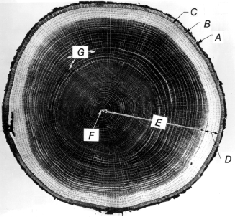C. Sapwood and Heartwood
Sapwood is located between the cambium and heartwood (Fig. 2–1D). Sapwood contains both living and dead cells and functions primarily in the storage of food; in the outer layers near the cambium, sapwood handles the transport of water or sap. The sapwood may vary in thickness and number of growth rings. Sapwood commonly ranges from 4 to 6 cm (1-1/2 to 2 in.) in radial thickness. In certain species, such as catalpa and black locust, the sapwood contains few growth rings and usually does not exceed 1 cm (1/2 in.) in thickness. The maples, hickories, ashes, some southern pines, and ponderosa pine of North America and cativo (Prioria copaifera), ehie (Guibourtia ehie), and courbaril (Hymenaea courbaril) of tropical origin may have sapwood 8 to 15 cm (3 to 6 in.) or more in thickness, especially in second-growth trees. As a rule, the more vigorously growing trees have wider sapwood. Many second-growth trees of merchantable size consist mostly of sapwood. In general, heartwood consists of inactive cells that do not function in either water conduction or food storage. The transition from sapwood to heartwood is accompanied by an increase in extractive content. Frequently, these extractives darken the heartwood and give species such as black walnut and cherry their characteristic color. Lighter colored heartwood occurs in North American species such as the spruces (except Sitka spruce), hemlocks, true firs, basswood, cottonwood, and buckeye, and in tropical species such as ceiba (Ceiba pentandra), obeche (Triplochiton scleroxylon), and ramin (Gonystylus bancanus). In some species, such as black locust, western redcedar, and redwood, heartwood extractives make the wood resistant to fungi or insect attack. All darkcolored heartwood is not resistant to decay, and some nearly colorless heartwood is decay resistant, as in northern white cedar. However, none of the sapwood of any species is resistant to decay. Heartwood extractives may also affect wood by (a) reducing permeability, making the heartwood slower to dry and more difficult to impregnate with chemical preservatives, (b) increasing stability in changing moisture conditions, and (c) increasing weight (slightly). However, as sapwood changes to heartwood, no cells are added or taken away, nor do any cells change shape. The basic strength of the wood is essentially not affected by the transition from sapwood cells to heartwood cells. In some species, such as the ashes, hickories, and certain oaks, the pores (vessels) become plugged to a greater or lesser extent with ingrowths known as tyloses. Heartwood in which the pores are tightly plugged by tyloses, as in white oak, is suitable for tight cooperage, because the tyloses prevent the passage of liquid through the pores. Tyloses also make impregnation of the wood with liquid preservatives difficult.
Fig. 2-1
